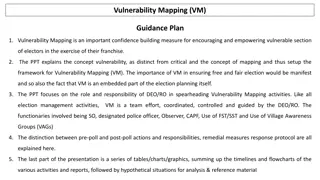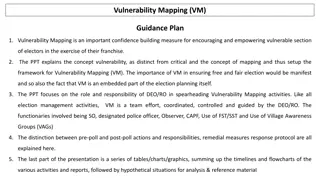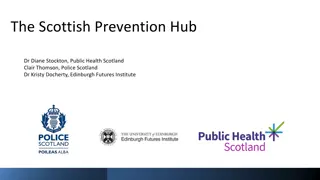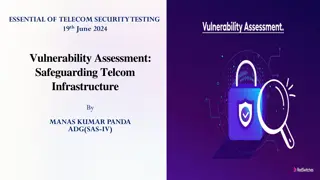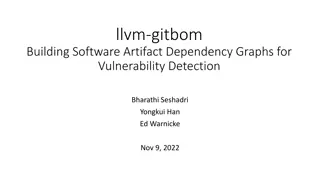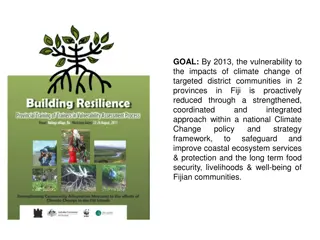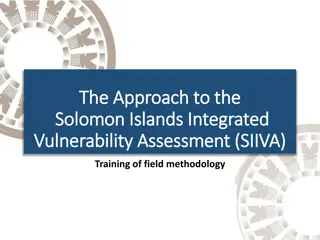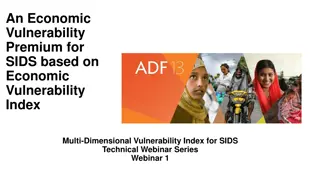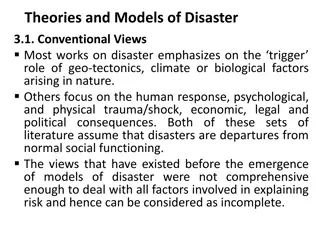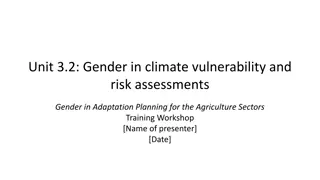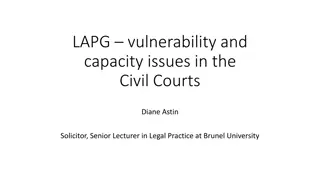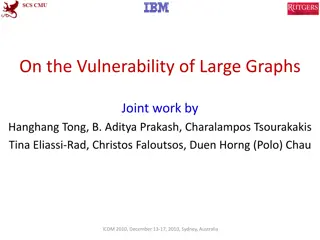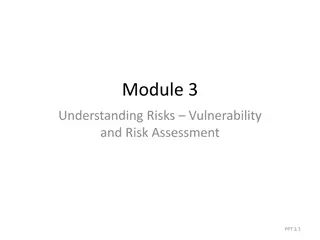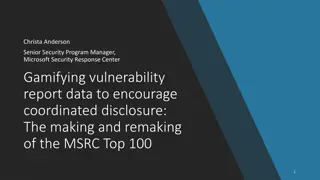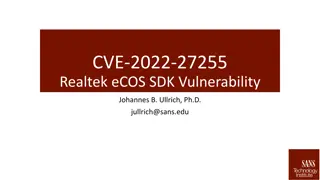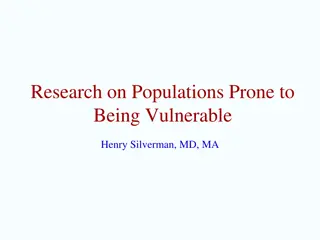Understanding Vulnerability: Meaning, Types, and Factors affecting Vulnerability
This article explores the concept of vulnerability, including its meaning, types (physical and social), and factors that contribute to vulnerability. It discusses the impact of hazardous events on communities, infrastructure, and the environment, and highlights the importance of awareness and prepar
26 views • 31 slides
Enhancing Cybersecurity with Bluedog VAPT Services
Bluedog Security Monitoring offers essential cybersecurity services, including Vulnerability Assessment and Penetration Testing (VAPT). Their automated VAPT combines External Vulnerability Scanning and WebApp Scanning to provide comprehensive testing solutions that help businesses prioritize risks,
0 views • 16 slides
Understanding Risk Management in Environmental Geography and Disaster Management
Risk management in environmental geography and disaster management involves assessing the potential losses from hazards, evaluating vulnerability and exposure, and implementing strategies to mitigate risks. It includes calculating risk, dealing with risk through acceptance, avoidance, reduction, or
1 views • 10 slides
Understanding Vulnerability Mapping (VM) for Ensuring Free and Fair Elections
This PowerPoint presentation delves into the concept of vulnerability mapping (VM) in the context of election planning, emphasizing the role of District Electoral Officers (DEOs/ROs) in controlling the entire VM process. It outlines pre-poll and poll-day responsibilities, as well as post-poll action
2 views • 36 slides
Comprehensive Guide to Vulnerability Mapping in Election Planning
Explore the significance of Vulnerability Mapping (VM) in empowering vulnerable voters, understand the concept, role of DEO/RO, and the objective of identifying and addressing voter vulnerability. The presentation emphasizes pre-poll and post-poll actions, remedial measures, and timelines, providing
3 views • 42 slides
Modeling and Generation of Realistic Network Activity Using Non-Negative Matrix Factorization
The GHOST project focuses on the challenges of modeling, analyzing, and generating patterns of network activity. By utilizing Non-Negative Matrix Factorization (NMF), realistic network activity patterns can be created and injected into live wireless networks. Understanding and predicting user behavi
4 views • 28 slides
Vulnerability Mapping (VM).Guidance Plan
Vulnerability Mapping (VM) is crucial in empowering vulnerable voters by identifying and addressing potential threats to their exercise of franchise. This guide explains the concept of vulnerability mapping, its role in ensuring free and fair elections, and the responsibilities of election officials
2 views • 42 slides
Understanding Vulnerability and Health Challenges in Scotland
Scotland's health challenges are highlighted through data on vulnerability markers such as sexual crimes, mental health issues, and rising missing person rates. Primary prevention is identified as a critical area needing attention to address entrenched challenges and societal impacts like the cost o
1 views • 20 slides
Understanding Telecom Security Testing: Vulnerability Assessment & Remediation
Telecom security testing is crucial for safeguarding infrastructure against hacks. Learn about vulnerability assessment, common weaknesses, types of vulnerabilities, severity scoring, and automated tools like Nessus and Nexpose. Explore network, web application, and host-based vulnerability testing
0 views • 18 slides
Effective Workflow for Vulnerability Research in Production Environments
Professional vulnerability research involves finding bugs efficiently through fuzzing techniques. The main goal is to develop a comprehensive workflow and toolset for effective bug discovery and triaging. Ancillary goals focus on determining exploitability, optimizing human and CPU efficiency, and e
0 views • 69 slides
Leveraging Artifact Dependency Graphs for Software Vulnerability Detection
Explore how LLVM-GitBOM utilizes artifact dependency graphs to detect vulnerabilities in software dependencies. The presentation covers the overview of GitBOM, CVE detection, supply chain vulnerabilities, and the importance of precise build tools in vulnerability scanning. Learn about utilizing gito
0 views • 34 slides
Understanding the Vulnerability Index for Small Island Developing States
This article discusses the concept of vulnerability in the context of countries, focusing on Small Island Developing States (SIDS). It explores the differences between vulnerability and poverty, the history of vulnerability index development from SIDS to Least Developed Countries (LDCs), and critiqu
8 views • 44 slides
Enhancing Climate Resilience in Fiji Through Ecosystem Protection and Community Engagement
The project aims to reduce vulnerability to climate change impacts in targeted Fijian communities by strengthening coastal ecosystem services, protection, and food security. Key components include mangrove protection, community-based adaptation, and policy integration within national frameworks to e
0 views • 8 slides
Integrated Vulnerability Assessment and Human Security for Sustainable Livelihoods in the Solomon Islands
The approach to the Solomon Islands Integrated Vulnerability Assessment (SIIVA) and the Integrated Vulnerability and Adaptation Assessment (IVA) are key methodologies to assess climate change risks and prepare nations for adaptation. The objectives include informing national climate change policies,
0 views • 21 slides
Comprehensive Guide to Penetration Testing Execution Standard (PTES)
Penetration Testing Execution Standard (PTES) is a crucial methodology to simulate attackers' methods for compromising security controls and gaining access to systems. The PTES process involves phases such as Pre-Engagement, Intelligence Gathering, Threat Modeling, Vulnerability Analysis, Exploitati
3 views • 14 slides
Network Compression Techniques: Overview and Practical Issues
Various network compression techniques such as network pruning, knowledge distillation, and parameter quantization are discussed in this content. The importance of pruning redundant weights and neurons in over-parameterized networks is highlighted. Practical issues like weight pruning and neuron pru
0 views • 37 slides
Network Slicing with OAI 5G CN Workshop Overview
Overview of Network Slicing with OAI 5G CN workshop focusing on the crucial role of network slicing in realizing the service-oriented 5G vision. This workshop covers topics like multiple logical networks creation on shared infrastructure, different types of network slices, preparation and instantiat
1 views • 6 slides
Economic Vulnerability Premium for SIDS - Webinar Insights
Presentation outlines applying Economic Vulnerability Index (EVI) for an Economic Vulnerability Premium in Small Island Developing States (SIDS) during ADF 13 cycle. Details ADF grants availability, grant allocation framework, performance-based allocation system, and modifications needed for SIDS.
0 views • 14 slides
Understanding Theories and Models of Disaster
Works on disaster traditionally focus on natural triggers and human responses, but older views are considered incomplete. The Pressure-Release Model (PAR) explains vulnerability and risk reduction, highlighting underlying causes and unsafe conditions. Root causes such as economic, demographic, and p
0 views • 17 slides
Network Monitoring and Vulnerability Scanning Overview
Kashif Mohammad from the Department of Physics at the University of Oxford provides insights into their setup involving ZEEK, ELK Monitoring, and OpenVas for network monitoring and vulnerability scanning. The team aims to enhance network security through structured classification of nodes based on t
1 views • 10 slides
Understanding Snort: An Open-Source Network Intrusion Detection System
Snort is an open-source Network Intrusion Detection System (NIDS) developed by Cisco, capable of analyzing network packets to identify suspicious activities. It can function as a packet sniffer, packet logger, or a full-fledged intrusion prevention system. By monitoring and matching network activity
0 views • 23 slides
Gender Considerations in Climate Vulnerability and Risk Assessments for Agriculture
This training workshop explores the intersection of gender, climate vulnerability, and risk assessments in adaptation planning for the agriculture sectors. It delves into how women and men may experience climate change effects differently and discusses ways to ensure gender considerations are includ
0 views • 6 slides
Understanding Vulnerability and Capacity Issues in Civil Courts
Exploring vulnerability and capacity issues in civil courts, this content delves into the importance of addressing vulnerabilities of parties and witnesses for ensuring fair participation and quality evidence in legal proceedings. Topics covered include factors contributing to vulnerability, the rol
0 views • 21 slides
Transportation Network Modeling and Analysis with C.Coupled SE Platform
This content outlines the features and functionalities of the C.Coupled SE Platform (CSET Platform) developed by the Connetics Transportation Group. It covers aspects such as interface design, inputs merging, purposes, platform development using Cube, TAZs merging, and network attributes. The platfo
0 views • 11 slides
Coastal Vulnerability Assessment of Curacao, Netherlands Antilles
Conduct a comprehensive Coastal Vulnerability Audit of Curacao, Netherlands Antilles, using the Coastal Vulnerability Audit Tool (CVAT) to assess physical, human, and engineering infrastructure systems, as well as vulnerability, planning, and resiliency action plans. Consider factors such as climati
0 views • 10 slides
Understanding the Vulnerability of Large Graphs in Network Analysis
This joint work delves into the vulnerability of large graphs in network analysis, focusing on immunization strategies to combat the spread of viruses. The study explores the optimization of immunization efforts by identifying the most crucial nodes for immunization, offering insights into safeguard
0 views • 21 slides
Meridian: An SDN Platform for Cloud Network Services
Meridian is an SDN platform developed by Mohammad Banikazemi, David Olshefski, Anees Shaikh, John Tracey, and GuohuiWang at IBM T. J. Watson Research Center. The platform focuses on providing cloud network services efficiently. It encompasses an architecture that enables faster and more convenient n
0 views • 21 slides
Reimagining Vulnerability: Rethinking the Body and Human Dignity
The notion of vulnerability is explored within the framework of the human body and dignity, challenging traditional concepts of autonomy and independence. Scholars like Martha Nussbaum and Fineman provide insights on the universal nature of vulnerability and advocate for a shift towards recognizing
0 views • 21 slides
Understanding Risks and Vulnerability in Risk Assessment
This module focuses on understanding risks, vulnerability, and conducting risk assessments in disaster risk management. It covers terminologies such as threats, hazards, vulnerability, and exposure, essential for prioritizing risks and initiating risk reduction measures.
0 views • 24 slides
Gamifying Vulnerability Reporting for Coordinated Disclosure at Microsoft Security Response Center
Christa Anderson, a Senior Security Program Manager at Microsoft's Security Response Center, discusses the importance of gamifying vulnerability report data to encourage coordinated disclosure. The MSRC Top 100, announced at Black Hat USA, plays a crucial role in the public credit strategy by recogn
0 views • 13 slides
Understanding Network Analysis: Whole Networks vs. Ego Networks
Explore the differences between Whole Networks and Ego Networks in social network analysis. Whole Networks provide comprehensive information about all nodes and links, enabling the computation of network-level statistics. On the other hand, Ego Networks focus on a sample of nodes, limiting the abili
0 views • 31 slides
Permafrost Carbon Research Network: Assessing Organic Matter Decomposibility for Climate Impact
This research network, led by Dr. Ted Schuur at the University of Florida, focuses on understanding the decomposition of organic matter in permafrost regions and its potential impact on climate change. Through data syntheses and active working groups, the network aims to quantify uncertainties and a
0 views • 18 slides
Realtek eCOS SDK Vulnerability (CVE-2022-27255) Summary and Defensive Measures
A critical vulnerability (CVE-2022-27255) affecting devices with Realtek RTL819x SoC has been identified, posing risks such as crashing, running arbitrary code, and network manipulation. Steps for detecting, isolating vulnerable devices, and minimizing exposure are crucial to prevent potential attac
0 views • 6 slides
Enhancing Nuclear Security Through Creative Vulnerability Assessment
Creative and effective vulnerability assessment and testing are essential in nuclear security to identify weaknesses and improve defense systems against intelligent adversaries. The need for in-depth assessment and realistic testing is emphasized to uncover vulnerabilities that adversaries may explo
0 views • 8 slides
Network Function Virtualization (NFV) Overview
Network Function Virtualization (NFV) focuses on virtualizing network functions to improve efficiency and reduce costs in network infrastructure. The lecture discusses key readings, devices that compose a network, specialization of devices, benefits of one-device-does-anything approach, and the goal
0 views • 21 slides
Enhancing Network Stability with Network Monitoring Systems
Network monitoring is crucial for efficient management and proactive issue detection in a network environment. Factors influencing an effective network system include choosing the best OEM, SLA agreements, and selecting a reliable System Integrator. Reactive monitoring can lead to financial losses a
0 views • 12 slides
Understanding Vulnerability in Research Populations
Vulnerability in research populations refers to being exposed to harm without the ability to protect oneself adequately. Factors contributing to vulnerability include intrinsic limitations like decision-making capacity and situational influences such as political or economic circumstances. Different
0 views • 22 slides
Exploring Vulnerability and Power Dynamics in Imperial Rome: Phaedrus' Perspective
Delve into the intricate relationship between constructions of vulnerability in imperial Latin texts and the material reality of vulnerability in ancient Rome. Discover how cultural perceptions of male citizen invulnerability rely on affirming vulnerability in others. Uncover the strengths of vulner
0 views • 10 slides
Accelerating Systemic Change Network Inaugural Workshop Summary
The Accelerating Systemic Change Network held its inaugural workshop at Howard Hughes Medical Institute in July 2016 to address the lack of coordination in improving higher education. With a vision to become a professional hub for change researchers in STEM education, the network aims to enhance ind
0 views • 5 slides
University Network Section Overview July 2015 - March 2016
The presentation covers the network team structure, team members, objectives, goals, report outline, network statistics, accomplishments, and future plans of the university network section from July 2015 to March 2016. It highlights efforts to provide stable internet and intranet services, restructu
0 views • 16 slides




